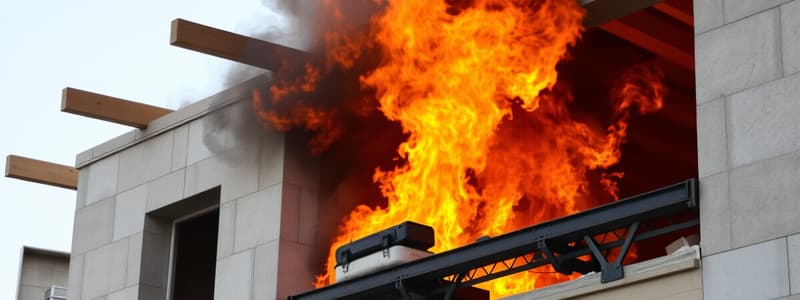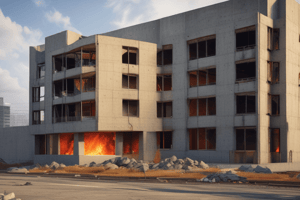Podcast
Questions and Answers
What is one consequence of the increased use of plastics in modern building materials?
What is one consequence of the increased use of plastics in modern building materials?
- Higher fire loads and faster fire growth rates (correct)
- Reduced fire load in structures
- Slower fire growth rates
- Improved performance of fire-resistant materials
How can carpeting on walls and ceilings affect fire safety?
How can carpeting on walls and ceilings affect fire safety?
- It poses additional hazards due to high flame spread potential (correct)
- It provides insulation and reduces fire spread
- It helps in prioritizing fire-retardant materials
- It is less flammable than floor carpeting
What is a key challenge for fire suppression systems in buildings with modern materials?
What is a key challenge for fire suppression systems in buildings with modern materials?
- They rely solely on manual operation to be effective
- Rapid fire spread can occur even with systems like sprinklers in place (correct)
- They are often too powerful for residential use
- They are less effective against fires that start outdoors
What strategy can significantly reduce the risk of rapid fire growth in buildings?
What strategy can significantly reduce the risk of rapid fire growth in buildings?
What is necessary for fire-retardant coatings to be effective?
What is necessary for fire-retardant coatings to be effective?
What are the four essential elements required for fire, commonly referred to as the Fire Tetrahedron?
What are the four essential elements required for fire, commonly referred to as the Fire Tetrahedron?
Which method of heat transfer involves the transfer of heat without direct contact between objects?
Which method of heat transfer involves the transfer of heat without direct contact between objects?
During which stage of compartment fires does the fire start to spread to adjacent combustible materials?
During which stage of compartment fires does the fire start to spread to adjacent combustible materials?
What characterizes the flashover stage of a compartment fire?
What characterizes the flashover stage of a compartment fire?
Which type of heat transfer is primarily responsible for the spread of hot gases in a fire?
Which type of heat transfer is primarily responsible for the spread of hot gases in a fire?
What is the initial phase of a fire called, which usually involves a small number of combustibles?
What is the initial phase of a fire called, which usually involves a small number of combustibles?
Which of the following is NOT an essential component of fire behavior?
Which of the following is NOT an essential component of fire behavior?
What is an advanced method used for analyzing fires in compartments?
What is an advanced method used for analyzing fires in compartments?
What occurs during the smoldering/decay stage of a fire?
What occurs during the smoldering/decay stage of a fire?
How does the ceiling layer contribute to a compartment fire?
How does the ceiling layer contribute to a compartment fire?
What determines the growth and intensity of a compartment fire?
What determines the growth and intensity of a compartment fire?
What phenomenon happens when hot, unburned fuel gases ignite suddenly at the ceiling layer?
What phenomenon happens when hot, unburned fuel gases ignite suddenly at the ceiling layer?
What is the primary cause of backdraft in a fire scenario?
What is the primary cause of backdraft in a fire scenario?
What is a significant influence on flame spread within a building?
What is a significant influence on flame spread within a building?
What are hidden hazards in the context of building or contents hazard?
What are hidden hazards in the context of building or contents hazard?
Which interior finish material can significantly contribute to fire growth due to its combustibility?
Which interior finish material can significantly contribute to fire growth due to its combustibility?
Which statement accurately describes void spaces in buildings?
Which statement accurately describes void spaces in buildings?
What role does wind play in fires within enclosed compartments?
What role does wind play in fires within enclosed compartments?
What is a consequence of rapid fire growth as seen in historical fire incidents?
What is a consequence of rapid fire growth as seen in historical fire incidents?
What happens to steel when exposed to high fire temperatures?
What happens to steel when exposed to high fire temperatures?
What type of materials are often found in void spaces that poses fire hazards?
What type of materials are often found in void spaces that poses fire hazards?
Flashcards are hidden until you start studying
Study Notes
The Basics of Fire and Fire Behavior
- Definition of Fire: A rapid oxidation reaction producing heat and light.
- Fire Tetrahedron: Four essential elements - Fuel, Oxidizing Agent (typically oxygen), Heat, and Uninhibited Chemical Chain Reaction.
- Methods of Heat Transfer:
- Conduction: Heat transfer through direct contact.
- Convection: Heat transfer via gases or liquids; hot gases distribute heat around fire.
- Radiation: Heat transfer through electromagnetic waves, igniting nearby materials.
Compartment Fires
- Compartment Definition: An enclosed space, like a room, where fire behavior is influenced by building construction.
- Fire Stages:
- Incipient Stage: Initial fire phase with small combustibles.
- Free-Burning Stage: Fire spreads, growing in intensity and size.
- Flashover: Critical point where surfaces ignite simultaneously, increasing danger.
- Smoldering/Decay Stage: Fire consumes oxygen and fuel, flames diminish, but heat persists.
- Key Components:
- Fire Plume: A column of flames, smoke, and heated gases from the fire.
- Ceiling Layer: Hot gases collecting at the top, radiating heat downward.
- Neutral Plane: Interface between hot ceiling gases and cooler air where bidirectional flow occurs.
- Entrainment: Fresh air drawn into the fire, enhancing growth.
Phenomena Associated with Compartment Fires
- Flameover (Rollover): Ignition of accumulated hot gases at the ceiling, causing flames to roll.
- Flashover: Room ignites almost simultaneously due to intense radiant heat.
Factors Influencing Compartment Fires
- Oxygen Supply: Location affects fire growth; open doors versus closed doors significantly influence oxygen availability.
- Wind-Driven Fires: Wind enhances fire spread, requiring tactical management during firefighting.
- Material Behavior:
- Steel weakens under heat.
- Aluminum melts at 1200°F (649°C).
- Various plastics respond differently to heat; some may char or melt.
- Fire duration impacts material degradation.
- Backdraft: Occurs when oxygen reintroduces to depleted fiery gases, leading to sudden combustion.
Fire Growth and Spread
- Fire Growth: Increase in fire size/intensity from fuel consumption; rapid growth can lead to catastrophic events, like the Cocoanut Grove nightclub fire in 1942 (492 fatalities).
- Flame Spread: Movement of flames across material surfaces; influenced by building materials which can conceal combustible materials.
- Hazards:
- Hidden Hazards: Combustible materials hidden in structural components.
- Exposed Hazards: Visible materials enhancing fire growth.
Examples of Fire Growth
- Dorothy Mae Apartments (1982): Flame spread over plywood leading to 24 deaths.
- Elliott Chambers Boarding House (1984): Rapid plywood fire spread resulted in 15 fatalities.
- Pioneer Hotel Fire (1979): Carpeting contributed to fire spread, causing 29 deaths.
Contributing Factors to Fire Growth
- Interior Finishes:
- Combustible Acoustical Tile: Conceals voids for undetected fire spread.
- High-Density Fiberboard: Contributes to significant fire hazards.
- Adhesives: Flammable substances that enhance fire spread.
- Void Spaces: Hidden areas, like above ceilings, where fire can spread unnoticed (e.g., Silver Spring, Maryland fire in 1977).
- Foamed Plastics: Can lead to rapid fire growth if not protected; notable case in Browns Ferry Nuclear Power fire.
Fire Growth in Modern Buildings
- Modern Materials: Increased plastic use leads to higher fire loads and faster growth; carpeting on walls poses additional risks.
- Suppression Challenges:
- Sprinklers may not be effective against highly combustible materials.
- Fire-resistant materials may not perform well in real conditions, necessitating stricter safety measures.
Control of Rapid Fire Growth
- Mitigation Strategies:
- Remove High Flame Spread Surfaces: Replace combustible materials to lower risks.
- Separate Combustibles from Ignition Sources: Prevent fire initiation and spread.
- Fire-Retardant Coatings: Must be applied properly to reduce flame spread effectively.
Studying That Suits You
Use AI to generate personalized quizzes and flashcards to suit your learning preferences.




